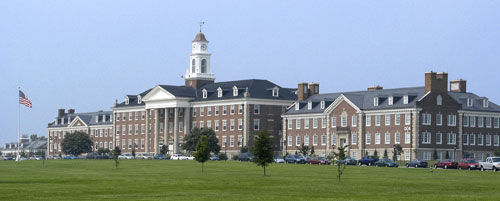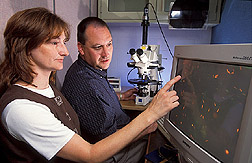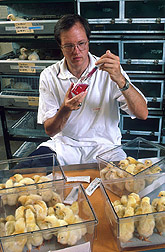 A new year and new challenges arise for science at BARC, Henry A. Wallace “National” Beltsville Research Center (BARC) and the National Agricultural Library (NAL) at the Abraham Lincoln Building
A new year and new challenges arise for science at BARC, Henry A. Wallace “National” Beltsville Research Center (BARC) and the National Agricultural Library (NAL) at the Abraham Lincoln BuildingThe Henry A. Wallace Beltsville Agricultural Research Center10300 Baltimore Ave., Beltsville, MD 20705
Here are the issues of concern and the request for their solution.
1. The people of the United States and the world are being told that we can no longer afford to continue research in long term critical areas of knowledge. The scale insect position systematist within BARC is now empty due to retirement, and the agency’s inability to rehire because of lack of funds. The National Agricultural Research Alliance - Beltsville strongly urges finding a $500,000.00 appropriation to continue this work. Scales are some of the most important invasive insects that damage a lot of our crops and also come ofter through imported agricultural products.
The hemlock woolly adelgid, Adelges tsugae, has been in the United States since 1924.
2. In May 2008 some programs in climate change research will be closed down, at a time when we are having a national and international important and urgent conversation on what are the impacts of, and responses to global climate change. Crucially needed on-going research is marked for termination in the President’s proposed FY 2009 budget. This needs to be avoided, and the program should be continued with its current funding and, if possible, receive more funds.
3. We fully support redirected research in the FY 2009 President’s budget including the proposed relocation staff and program from the Grand Forks Human Nutrition Research Center to Beltsville.
 At the Biotechnology and Germplasm Laboratory in Beltsville, Maryland, physiologists Julie Long and Kurt Zuelke evaluate whether turkey sperm are alive or dead in studies to improve the lifespan of stored turkey sperm. Photo by Stephen Ausmus.
At the Biotechnology and Germplasm Laboratory in Beltsville, Maryland, physiologists Julie Long and Kurt Zuelke evaluate whether turkey sperm are alive or dead in studies to improve the lifespan of stored turkey sperm. Photo by Stephen Ausmus.4. There is much about the President’s budget to be concerned. The Animals Biosciences & Biotechnology Laboratory (ABBL) at ARS-BARC research mission is to improve the genetic, reproductive, and feed efficiency of livestock and poultry. It is proposed for elimination. A dedicated staff of 32 employees, of which 13 are research scientists, are addressing a number of cutting-edge research issues such as using pig embryonic stem cells to enhance disease resistance in pigs and for clinical use in human liver rescue devices; designing novel antimicrobial proteins for treatment of human (methicillin-resistant staph aureus) and animal (bovine mastitis) diseases; and identifying genetic markers to reduce fetal pig mortality. This cutting-edge work is well regarded in the greater scientific community. Loss of this funding will essentially close out the only research of this type in ARS. It has been suggested that a reason for the proposed closure is inadequacy of facilities. In the judgment of highly qualified scientists, the inadequacy of facilities is not an issue. The research in this laboratory is both basic and applied and is valuable to all of the animal industries. The research addresses the very issue of genetic improvement of animals for those traits that are most desirable to consumers and profitable for producers. In addition, this research has proven to be very valuable to the biomedical community because the information obtained is useful to promote human health. Restoration of funding, $8,401,123.00, for this invaluable research is critically needed.
4. The ARS- BARC Biomedical Materials in Plants program’s elimination is proposed. Plants can be used as factories to manufacture vaccines and other pharmaceuticals for animals and humans. This research focuses on development of tobacco as a crop with this beneficial use. The National Agricultural Research Alliance – Beltsville, NARA-B, urges the restoration of full funding in the amount of $1,808,253.00.
5. The timely and important work in the field of bioremediation of munitions storage sites and bombing ranges in parts of the U.S. have left huge tracts of soils and lands contaminated by highly toxic residues from explosives like TNT. Those soils and lands now are limited because of their environmental damage for use in commercial or agricultural purposes. The funds support ongoing ARS research to determine if forage plants can remove TNT and its metabolites from contaminated sites. Beltsville is a world recognized leader in the field of bio-remediation. This work is not done anywhere else in ARS. The Alliance recommends funding of $118,167.00 for this research.
6. Foundry Sand By-Products Utilization is also cut in the President’s FY 2009 proposal to Congress. Waste sands from the metal casting industry are currently dumped in landfills. This project is working with industry on guidelines for beneficial uses of these sands. We recommend that this research continue and ask for $680,205.00 to be restored.
7. Poultry Diseases and the protection and security of our food chain are at risk with the proposed elimination of on-going research. Coccidiosis, a parasitic poultry disease, costs the industry almost $3 billion per year. This research focuses on understanding the genetics of both the parasite and the host chicken to identify targets that will allow better disease prevention and control. We recommend $434,934.00 be restored so that this research continues.

Microbiologist Harry Danforth and other scientists laid groundwork for development of animal disease vaccines, including one for chicken coccidiosis. Photo by Keith Weller.
8. Funding for Potato Diseases programs are used for research activities on genetic improvement of potato and for diseases of potato. While a small amount of money, these funds are used to supplement ongoing efforts in this important area. We recommend that this research continue to be funded in the amount of $64,545.
The redirected Research budgetary items listed here have not appeared in testimony of previous years. In terms of overall ARS-BARC funding, they are revenue neutral. Essentially, these are “new” programs replacing similar but lower-priority, on-going programs that would be closed out. Ideally, all the research programs, new and old, would continue. All are important lines of research, and we would prefer to see new funding rather than redirection. Nevertheless, BARC can manage within these re-directions if there is no option. We strongly support funding for these research programs.
9. Crop Health - $947,322.00
10. Obesity Prevention Initiative - $1,937,649.00 11. Food Safety - $1,045,629.00
12. Crop Genetic Improvement - $ 938,385.00
 13. Meanwhile the National Gardens and Education units, Congressionally mandated programs at the National Arboretum, are proposed to be cut by $2,000,000.00.
13. Meanwhile the National Gardens and Education units, Congressionally mandated programs at the National Arboretum, are proposed to be cut by $2,000,000.00.14. These programs have much in common with the National Agricultural Library (NAL), which is facing it's own funding problems and challenges. The Alliance concurs that funding for the NAL's AWIC and Special Collections budget must not be cut. The Alliance supports the arguments put forth in this letter sent to Representative DeLauro from Dr. Norma Kobzina, President, USAIN 2007-2008; Librarian, Marian Koshland Bioscience and Natural Resources Library, U.C. Berkeley.
10 March 2008
The Honorable Rosa DeLauro,Chairwoman, House Appropriations
Subcommittee on Agriculture, Rural Development, Food and Drug Administration and Related Agencies 2362A Rayburn House Office Building Washington, D.C. 20515-0616
Re: Support for the USDA National Agricultural Library (NAL) in the
Proposed Fiscal Year 2009 Budget
Dear Madam Chairwoman:
We are writing on behalf of USAIN, the United States Agricultural Information Network, to ask for your support as you and your colleagues begin the hearings on the proposed Fiscal Year 2009 appropriations for the U.S. Agricultural Research
Services (ARS) and the Department of Agriculture. We appreciate the efforts you
have made in ensuring that the USDA and related agencies are able to meet the
priorities of the new Farm Bill and to provide funding for research, safety for
consumers, and resources for the farming and rural communities.USAIN is an organization of more than 100 agricultural librarians and information
specialists, with members from five countries on three continents and more than
40 U.S. states. We work at land-grant and other universities, government agencies including the National Agricultural Library, and non-profit organizations. It is the work of USAIN members in their state and regional institutions (land-grant colleges and universities), Cooperative Extension units, as well as the National Agricultural Library, to facilitate access to key historical data and reports as well as to the latest scientific information upon which agricultural research is based.We are concerned that continued cuts in the budget, and the re-distribution of funding, will make it more difficult than ever to make sure that information resources are readily available to researchers, educators, agricultural extension agents, and others involved in the agriculture-related sector, as well as members of the general public. Immediate access to complete and current research regarding issues of national importance such as food security, renewable energy, and the health of our natural resources is absolutely vital for the future health and economic well-being and of American citizens. Federal support for agricultural research at universities and colleges has been steadily decreasing, and funding for the National Agricultural Library and significant collaborative initiatives such as AgNIC (the Agriculture Network Information Center) has remained flat since 1995. The President's FY 2009 Budget Estimate includes $18 million for the USDA National Agricultural Library, a $4 million reduction from the FY 2008 Budget estimate, and $6 million less than the FY 2007 actual budget for the Library.
Significant changes proposed by ARS include redirecting $993,000 in AWIC funds to support NAL participation in a new digital portal for veterinary medicine; eliminating funding for the National Agricultural Law Center, the nation's leading source for agricultural and food law research and information, which complements and works with NAL, which does not cover these areas; and most importantly, reducing funding for non-digital content/document delivery/Special Collections by $3,000,000.
"Plate Six, Lepidopterous Archippus" The Natural History of the Rarer Lepidopterous Insects of Georgia By John Abbot and James Edward Smith London, 1797
As a national library, the print collection is core to researchers and the agricultural history of the nation. It is this reduction of $3,000,000 for the print collections that is of immediate concern. In FY 2007, NAL document delivery services filled 29,000
requests from the NAL collection for materials which were available in print-only--not available electronically. In FY 20009, such requests for print-only materials would not be filled.
There is no question about the need for continued, increased support for the creation and delivery of digital content, and the need for more sophisticated systems for access based on new user requirements. NAL has been a leader in facilitating the development of innovative digital projects of national and international importance, such as AgNIC. We applaud the efforts to improve the quality of AGRICOLA, an electronic index to agricultural literature, and their creation of Digitop which provides desktop access of research materials to USDA staff worldwide. New web portals such as nutrition.gov and invasivespeciesinfo.gov have proven to be invaluable sources of free information for consumers and researchers alike. However, in the United States almost half of the population continues to rely on printed resources, without access to the Internet. Especially in rural communities, including farms and ranches, those who need the information rely heavily on printed leaflets, handbooks, books and trade journals. It is unlikely such material will be made available electronically in the immediate future. At the same time, it is not clear that agricultural information received from worldwide sources will become digitized in a timely fashion.
The ramifications of the proposed reductions or redirections of NAL funding include not only the inability for NAL to fill requests for materials available only in print, but the complete cessation of book and journal purchases, and the inability to catalog and make available print materials already acquired. In addition, cancellation of the receipt of free publications from the U.S. and other countries would have a major impact. In recent years the USDA required all USDA-authored publications to be delivered to the NAL; but what good is this if there no money to catalog them and make them findable? Publications coming from scholarly societies in addition to those from commercial publishers will no longer be available to USDA researchers, and in some instances to researchers, educators and librarians throughout the United States who utilize the collections housed at NAL.
Libraries throughout the United States rely on the NAL as its primary national depository for agricultural literature, in the same way that other libraries and the public rely on the Library of Congress or the National Library of Medicine. It should be noted that the materials collected by NAL are not frequently held in the Library of Congress. Universities and other institutions are also faced with budget cuts, and increasingly, have depended on regional and national partners to ensure that our patrons can access these shared print resources. USDA staff without ready access to the ARS field libraries or university collections would be further hampered in their research.In addition, one of the more severe impacts of the ARS proposal on researchers, scientists, educators and the general public is the suggested elimination of the NAL Special Collections Program. These collections are what makes the NAL unique and valuable for U.S. citizens, with materials in several subject areas-- entomology, plant science, and pharmacology, among other disciplines. Examples of the materials housed there, which are in constant need of preservation, include early herbals, heirloom plant varieties, the origins of invasive species, and the history of agriculture itself. Seed catalogs are another example of the unique collections housed at NAL. While there has been an attempt to preserve the most significant literature of agriculture and rural life, through grants such as those from the National Endowment for the Humanities ( a program formulated under the auspices of USAIN), the major portions of the Special Collections at NAL are often too brittle to be included in such preservation projects. A high percentage of these special collections have yet to be processed, and it was only recently that there was funding to improve the climate and physical space that is essential to maintain these rare items. Current efforts by the NAL working with several publishers who use the images and information will be difficult or impossible to continue if this funding proposal is approved. We fear the loss of these valuable, archival collections.
We recognize the difficulties you face in balancing budget priorities. However, NAL cannot continue to be a National Library if access to the vast print collections, and the ability to acquire, process and preserve, and make accessible online this material, is taken away. The vision of the National Agricultural Library and cooperating institutions is to create a comprehensive, collaborative information system, and we hope that you will support our efforts to achieve this vision.
We would be happy to address any questions you might have and to provide further input on this issue. We thank you in advance for your consideration.
Respectfully Submitted by
the USAIN Executive Council on behalf of the U.S. agricultural information
community. Dr. Norma Kobzina, President, USAIN 2007-2008Librarian, Marian
Koshland Bioscience and Natural Resources Library, U.C. Berkeley; Heather K.
Moberly, Past President, USAIN 2007-2008Associate Professor and Veterinary
Medicine Librarian at the Center for Veterinary Health Sciences at the Oklahoma
State University; Katie Newman, President-Elect, USAIN 2007-2008Associate
Professor and Biotechnology Librarian, Biotechnology Information Center,
University of Illinois
Maryland’s Congressional leaders, Mr. Hoyer, Ms. Mikulski, and Mr. Cardin are working to protect the scientific programs at BARC. In January 2008, the Maryland delegation asked USDA for a plan for the operation and direction of thetwo entities.
The Alliance is a full time volunteer effort with no funding. We need your help; please write to your Congress person and Senators asking them to support science at BARC % NAL.




